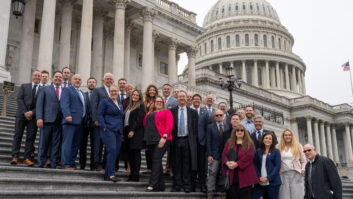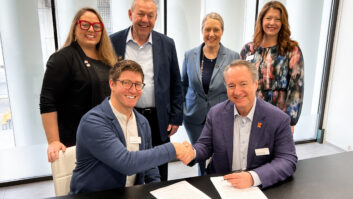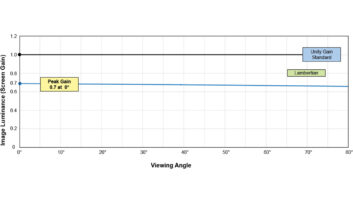In booth 136 at CEDIA EXPO in Denver next week, Stewart Filmscreen promises to show some of the most cutting-edge video displays that can be custom engineered to provide the best possible image and experience available for the residential market. The “Stewart Filmscreen 4K+ Ultra HD Experience Center at CEDIA EXPO,” will be headlined by a dedicated digital cinema room featuring a 15-foot wide Stewart Filmscreen GrayMatte Director’s Choice screen paired with commercial-grade projectors showing uncompressed native 4K content from Quantum Media Systems as part of the Company’s Quantum Private Theater package lineup.
But that’s only part of Stewart’s product story for CEDIA. To learn more about the company’s plans for the show, we turned to Grant Stewart, who recently returned to the president and CEO role for the company, to offer more insight into the projection screens leader.

Grant Stewart
There’s been a lot more news coming out of Stewart Filmscreen in the weeks leading up to CEDIA. What can you say about all of the recent activity at the company, particularly you staffing additions?
The AV industry and, quite specifically, the needs of our customers are constantly changing. It’s important for Stewart Filmscreen to be nimble and adapt to the changing environment, anticipate it even to get ahead and be ready for what’s next. There are so many ways we are changing in response to what we see happening in the market, it’s hard even for me to keep up sometimes. Take communications, for example. There’s nothing more important. Our customers need answers and information faster now than ever before. We’ve listened and learned from the challenges they face and we’ve dynamically reacted. We now have a dedicated marketing communications specialist, and added a new PR firm to accelerate distribution of our message and share stories of our successes.
We want to inspire our customers to keep dreaming big. We’ve also added senior sales and marketing leadership that is adding a broader base of custom and retail experience to our team than we’ve had in the past. We’re simplifying business processes to make it easier for our customers to conduct their business. With these changes, we are now a far more nimble, more customer-centric organization that actively collaborates with customers to identify the right solutions for their projects.
Taking it a step further, we’ve recently beefed up our R&D efforts adding a new lead chemist to help us explore newer and better ways to push the envelope. He’ll be keenly focused on how the applications of projection screens are changing and then actively develop solutions for them. We also have invested in a large expansion of our manufacturing capabilities in our Ohio plant. This is going to help us shorten lead times, something we know our customers want. I could go on and on. It’s a very exciting time for Stewart Filmscreen.
Stewart launched a new website, what are the differences between the old and new site and how does this reflect changes in your approach?
It mostly has to do with the way we specify screens. While we do ask for the ultimate application for your screen, we consider the designations “residential” and “commercial” less and less important. Sure, it will make a crucial difference in screen design if you are specifying a huge screen for a well-lit stage or a small screen for a dark home theater, but the lines between commercial and residential are blurring and more and more Stewart Filmscreen integrators are catering to both. So while the final application is important, we make it clear from the home page that we have solutions for just about everything—whether it is a standard dimension screen—what we are calling a “typical” solution—or a custom screen that’s designed and engineered specifically for the application.
We’re also working with our partners and customers to promote their successes by providing a library of case studies and installation stories on our site that features their work. It’s a way to showcase what they’re doing in the field and to provide end users with a visual representation that helps them make a decision as to what screen they’d like to have in their environment. It’s a way to give back to those that support us and that’s something that’s very important to me, and always has been to the Stewart Filmscreen family.
Explain a little bit more about your new screen size classification system on the website.
We’ve found that specifying screens, especially larger ones, can be incredibly confusing for many of our customers. To simplify the process, we have created three general seamless image size classifications that serve as a starting point: Standard (up to 9×12 feet), Large (up to 18×24 feet), and Stewart Large (up to 40×90 feet).
By classifying our screens this way, we are also differentiating our company and our product offering. Did you know that Stewart is the only manufacturer that can make screens as large as 40×90 feet without any seams? It’s true and it matters. We have dedicated onsite manufacturing with capabilities unique to Stewart Filmscreen.
In all honesty, there’s a bigger initiative that’s only just begun. We’re reducing turnaround times and refining processes. Our website has been completely redesigned, and it’s just been re-launched. The changes you’ll see today are subtle, but important. In time, it will be incredibly easy for all of our customers—regardless of whether they are in the trade or are an end-user—to shop, select, and specify products directly from the website. We want it to be simple for anyone who comes to the Stewart Filmscreen site to find what he or she is looking for, quickly, easily, and definitively.
Stewart has been in business for more than 65 years. How hard is it to execute change in an environment where tradition is part of the company’s DNA?
First off, some things will never change, nor should they. Quality and a commitment to custom products and designs as well as overall excellence will never be compromised. These are fundamental values at Stewart Filmscreen, and though we may sometimes falter, I’m so proud of the team and how they remain ever vigilant. As a recent recipient of ISO 9001:2008 certification, our processes include stringent quality controls and inspections that require a careful eye. Our customers require and appreciate this and we will never forego such attention to detail.
When change is for the right reason, we embrace it. For example, when you are leading with technical innovation and craftsmanship change is a natural and easy evolution. We are constantly studying the market and looking at why screens are needed and how they are being used. That excites us and challenges us. We want to come up with new products because they offer real benefits to the end user, not because we feel like we need to put something out there for arbitrary reasons.
Some products are timeless, but our newest materials feature tangible advancements and aren’t simply marketing hype. FireHawk G4, GrayHawk G3, and Tiburon G2 have all been refined and now better fulfill a wide variety of application-specific needs. While it’s been on the market a couple years now, I don’t want to overlook talking about Cima by Stewart Filmscreen. This line is a great example of how Stewart has the unique ability to recognize changes in the market and proactively engineer solutions to meet the challenges our customers face. As we came out of the Great Recession it was clear that budgets were going to remain tight for some time. Customers wanted great images but had to live within tighter means. We answered that call. By standardizing the solutions to a set of pre-determined sizes and redesigning some components just for those sizes we were able to bring to the market a set of solutions that met our expectations for quality and their expectations for value. And it’s been a huge success.
With CIMA by Stewart Filmscreen, we’re helping our dealers better understand how to successfully sell two-piece projection when challenged by flat panel-based options readily available to their customers at warehouse or big box stores. People know us as the high-end screen company, but with CIMA we have been able to address the needs of a different demographic, while still maintaining the integrity of our traditional screen materials and our commitment to the very best image quality possible.
Stewart’s material science is a thing of legend and lore in the industry. You’ve worked with Paramount, Lucas Films, Universal Studios, the Academy of Motion Picture Arts and Sciences, Government agencies, and have crafted some incredibly innovative specialty optical surfaces. What’s the secret?
We have what we consider to be a world-class material science and engineering department, including, a heavy investment in our research and development team that includes the addition of a lead chemist to both oversee our screen formulations and develop new ones to meet the needs of an ever-changing marketplace. This commitment to onsite manufacturing and dedicated material science is unique to Stewart Filmscreen and greatly benefits our customers. It means we can deliver the unimaginable. Dealers can call us with the craziest ideas for a screen, and 99 percent of the time, we can make it. That’s why Stewart Filmscreen products not only reside in the living rooms, media rooms and private theaters of homeowners around the world, but are the ones often used on the stage at the Academy Awards or in some of the most mission-critical commercial environments on earth, like flight and safety simulators and in government facilities. Material science is at the heart of everything we do.
What’s coming up for CEDIA EXPO? Can you give us a teaser?
You know I can’t spoil a great surprise. Come by the booth (136). There, we promise you’ll see some of—if not the—best images on the show floor. We’ve partnered with Sony, Digital Projection, Christie, and Quantum Media Systems to bring The Stewart Filmscreen 4K+ Ultra HD Experience Center at CEDIA EXPO to life. Attendees won’t want to miss this—and quite honestly can’t afford to. It’s the only booth where one will find the assortment of 4K+ viewing options.
Aside from that, you just never know. We’re famous (infamous according to some of our employees) for introducing a new concept hours before a show starts. The thing is, we can do that. Unlike other manufacturers who either don’t make their own screen materials and instead bring them in from offshore, our manufacturing is done right here in the USA. We’ve got a plant in Southern California and another in Ohio where we make our own screens, from the materials to the finished product. We can walk out to the plant and design a screen on the fly with zero obstacles. So, all I can say is swing by to see what’s new and maybe, just maybe, you’ll get a glimpse at the next big thing.
UHD seems to be the bandwagon every manufacturer is trying to hop on. Will you be introducing a special 4K Ultra HD screen at the show?
That’s a question we get a lot, but our screens have always been ready for whatever resolution is fired at them—whether it’s standard def, high-def, Ultra High Def, 6K, or even 8K and beyond. To make our position clear to the outside world, we’ve added the 4K+ logo and designation to all our screens so there’s no mistaking it: Stewart Filmscreen has been 4K+ Ultra HD since 1947!
That being said, at CEDIA EXPO in Denver, we’ll be showcasing the next level in home cinema that takes residential entertainment beyond a flat-panel TV and speakers to a true private cinema experience that is just as good as any commercial digital cinema. It’s all about taking 4K Ultra HD to its maximum potential and getting Digital Cinema quality like you’d find in a commercial theater, at home. We’re calling the booth at CEDIA EXPO The Stewart Filmscreen 4K+ Experience Center. We’ll be showing full, uncompressed native 4K content, including movie clips and specially created content, in a big theater on a Director’s Choice screen. No upscaling, no compression. Just pure, uncompressed native 4K content being seen as it was intended to be seen, on a massive 212-inch wide GrayMatte screen with a Director’s Choice variable 4-way masking system. Quantum Media Systems is providing the 4K+ Experience in this theater and it’s something dealers are going to want to take note of. It’s an incredible package solution that provides a far more immersive and impressive private digital cinema experience than anything else out there.
Where will Stewart be at this time next year?
I can’t be specific, of course, but there are a few things we will focus on over the next year. One, we will keep innovating. We have a long list of projects. Two, we will keep pushing ourselves to make it easier for our customers to do business with us. And three, we’re going to reinvest in our marketing and training by implementing a full workable and manageable screen configurator G3, and we hope to bring an in-house experience center online also.
We’re going to grow. We’re going to help our customers grow and prosper. And one thing’s for sure. Stewart Filmscreen will be an even more dominant leader in the category than ever before, but we will always remain true to our deep-rooted commitment to excellence in innovation, craftsmanship, support, engineering, design, and manufacturing.







